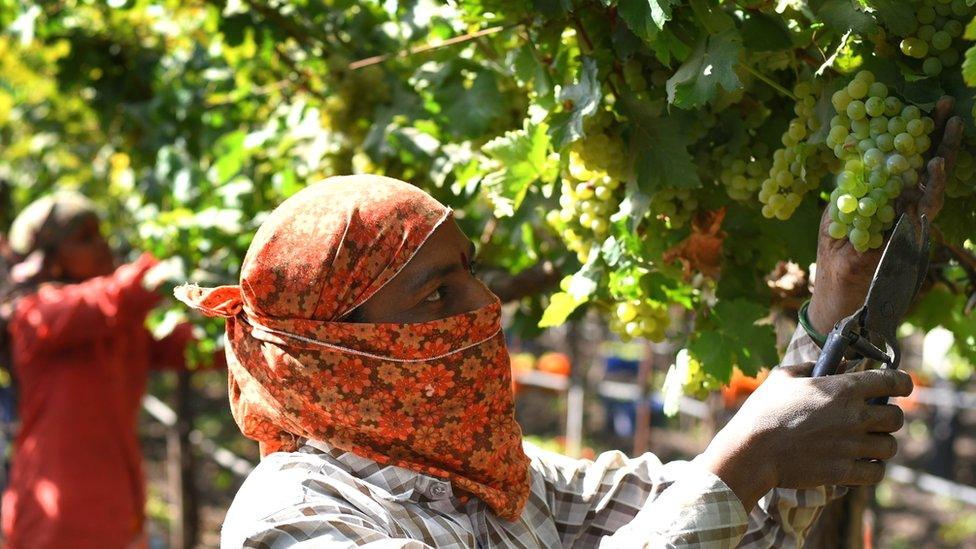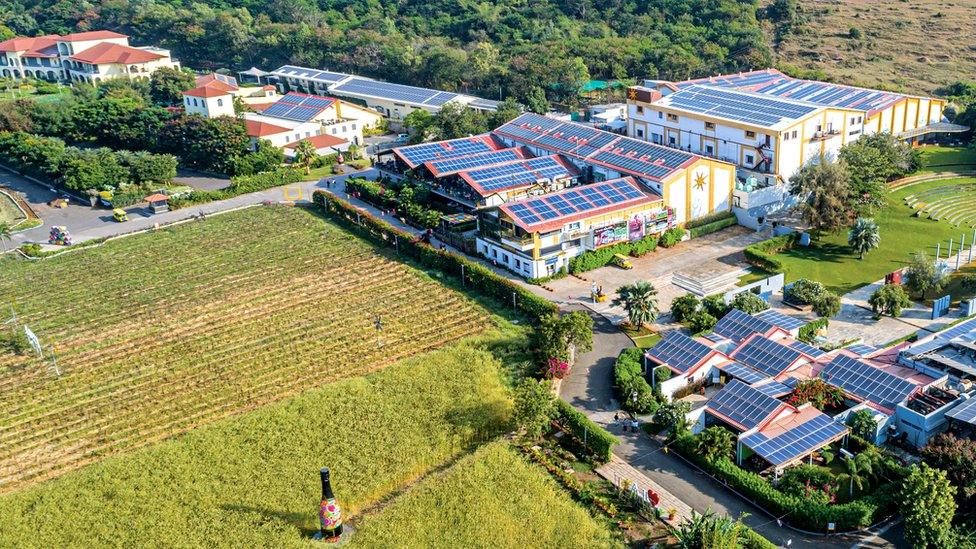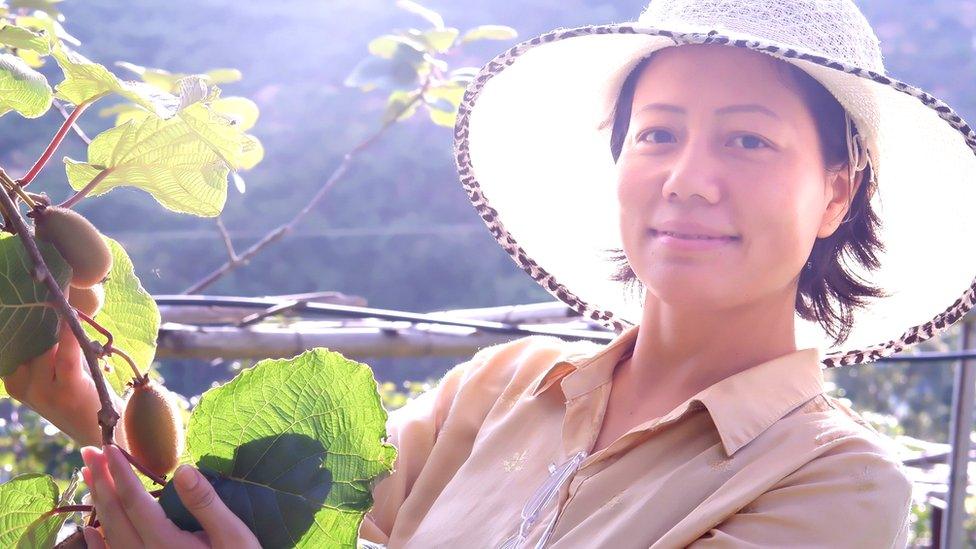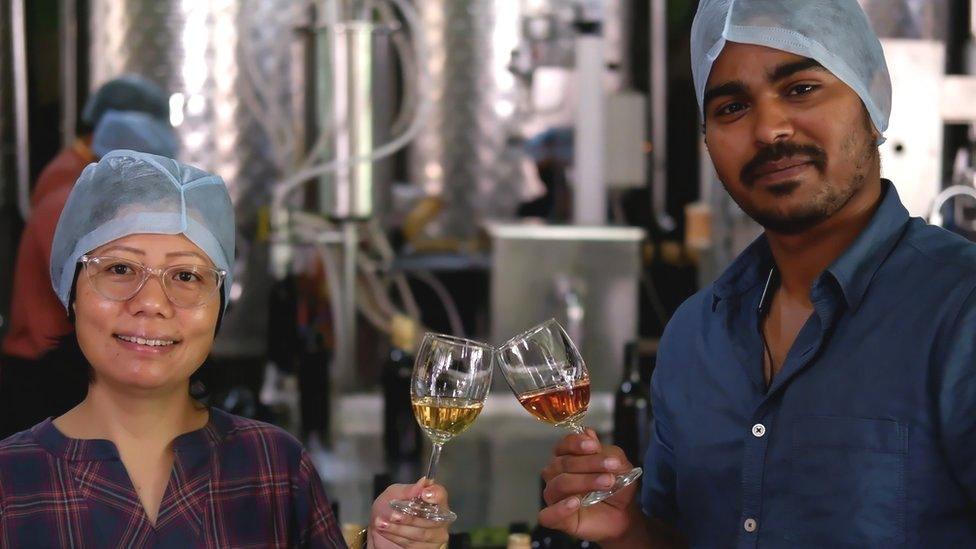Tropical vineyards put India on the wine map
- Published

Sula harvests its grapes at the end of the winter
What do you do to develop a wine industry in a country with no tradition of wine-drinking and a climate which doesn't favour grape-growing?
In India, innovative producers have adopted a range of approaches, from flipping the grape-growing season, to using kiwi fruit instead of grapes, to packaging wine in cans.
"When we started in 1997 no one knew what wine was," remembers Rajeev Samant, the founder of India's Sula Vineyards.
"All liquor shops in India were called wine shops, so people thought wine meant liquor," he says.
It wasn't just a branding problem. Hurdle after hurdle had to be cleared to get Sula up and running.
It took Mr Samant two years just to get a government licence to make wine from grapes.
Then he had to get the attention of consumers, who weren't much interested in wine.
"India is not traditionally a wine-drinking country - due to an earlier period of prohibition and higher prices, compared to spirits like whisky and brandy manufactured in the country."
And then there is the weather. Sula's base is Nashik, Maharashtra, where the climate is tropical. In March, April and May the temperature can easily top 40C.
"Climate is a challenge and always will be," says Mr Samant.

Sula's vineyard is in the tropics
Sula solved this by doing the opposite to the rest of the wine-growing world - it grows its grapes during the winter and then harvests them at winter's end.
The latest technology has also helped. Sula was the first Indian vineyard to use refrigerated stainless steel to store its wine.
"I realised to make good tropical wines it needs to be refrigerated. It is expensive, but for us it brings the quality," says Mr Samant.
But persistence has bought success. Sula now has 1,000 staff and annual sales of about 5bn rupees (£55m; $62m).
It has just launched its first share sale - raising almost 10bn rupees (£98m; $121m).
In addition, hundreds of thousands of people visit its vineyard in Nashik every year.
Later this year, Sula plans to sell shares on the stock market for the first time. It will be an opportunity to gauge what investors make of the prospects for the Indian wine market.
At the moment there are about 110 wineries in India, making wine and fruit wines.
The Indian government is keen to boost that number. It has a high tariff on imported wine and overseas companies are encouraged to invest in India.

Fratelli has launched wine in a can to attract younger drinkers
India's third-biggest winemaker is the result of an international collaboration.
In 2006, the Secci brothers (Alessio and Andrea) from Italy joined forces with the Mohite Patil brothers (Arjun and Ranjit) from Maharashtra, and the Sekhri brothers from Delhi (Kapil and Gaurav).
Together they formed Fratelli Wines.
"Wineries in India don't stick to rules or traditions as strictly as older wine-making countries do. Instead, India follows the New World wine-making style, which is more experimental and technologically oriented," says Jayanth Bharathi, from Fratelli Wines.
Its latest offering, wine in a can, would definitely make a traditional vintner shudder. Mr Bharathi says it will appeal to younger drinkers and make Fratelli's wines "approachable and casual".


He is confident such innovation will pay off.
"With an increasingly urban population, wine consumption is becoming a part of the cultural zeitgeist and with good quality Indian wines on the offering, there is very good chance for India to make a mark on the world wine map."
Given that India's climate is generally not kind to grapes, some entrepreneurs are betting on fruit wines.
Arunachal Pradesh is a state in the far north-east of India. The lower-altitude parts of the region have a subtropical climate and kiwis, pears, peaches and plums grow well there.
But poor marketing, transport and storage mean that a lot of that fruit goes to waste.

Tage Rita founded Naara Aaba in 2017
In 2017, Tage Rita decided to do something about that. She started making wine from kiwi fruit, an important crop in her valley.
Called Naara Aaba, it has a 13% alcohol content and became India's first-ever organic wine made from kiwi fruit.
"I wanted to revive the local farming community by sourcing its harvest, making wines from them and also preserving the healthy values of the exotic fruits," says Ms Aaba.
She is also proud of the boost the winery has given her local economy.
"The farmers of the valley have immensely benefited by selling their produce. It has provided income opportunities for farmers and jobs for unemployed youths," she says.
Kiwi wine is produced in much the same way as wine from grapes. Ripe fruit is juiced and fermented, taking three to four months to produce a batch of wine. Some products are aged for an extra four or five months before bottling.

Tage Rita and her staff at Naara Aaba makes about 50,000 bottles of fruit wine a year
Naara Aaba makes about 50,000 bottles of wine a year, including also wine from peaches, plums and pears.
"The advantage with fruit wines is that they require much less time to mature. Fruit wines are also lighter and fruitier, compared to grape wines, which are easier for new wine drinkers," says Ms Aaba.
"The social and cultural taboo around alcoholic beverages is slowly dissipating," says Subhash Arora, founder of the Indian Wine Academy, which promotes the industry.
While challenges remain, the outlook is bright, he says.
"It's difficult for us to become a global player, as we lack good weather and soils to grow the right kind of fruits to produce excellent wines, but we are reaching a milestone, where Indians are liking Indian-made wines."